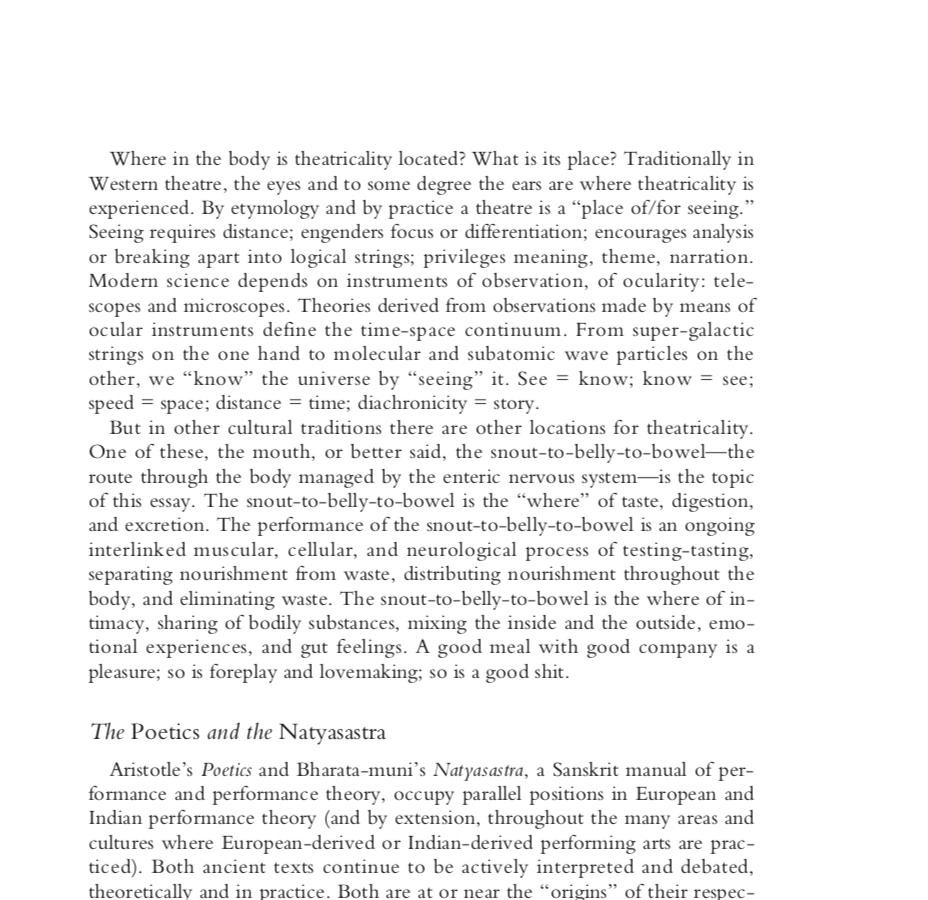Food and rasa-aesthetics
Rasaethetics, as defined by Richard Schechner, is an overall theory of flavor as it pertains to performance. This theory derives from Natyasastra (NS), a Sanskrit manual of performance and performance theory reconstructed from a collective, largely oral tradition that may go as far back as 600 BC. NS takes on a parallel role in Indian performance theory as Aristotle’s Poetics does in European performance. Western notions of theatricality draw from a long-standing tradition of syllogistic reasoning established by Aristotle around 340 BC. In Poetics, Aristotle proposes a rational, historically-grounded basis for theatre rooted in European epistemology. According to Aristotle, Eodipus and other Greek plays serve as theatrical archetypes; ideal forms from which all other plays and concepts of theatre derive, or should derive. In Greek notions of theatre we also see the underlying groundwork of the broader narrative of Western thought, whereby the idea of “knowing” is fundamentally tied to “seeing.” Thus, to understand something we must physically view it. This act of observation is performed at a distance from the subject observed with the goal of preserving observer objectivity; the isolation of the observer and observed is critical. As Schechner puts it, “by etymology and by practice a [Western] theatre is a “place of [and] for seeing.”
The concept of “rasa” originates in NS: “Rasa is the cumulative result of vibhava [stimulus], anubhava [involuntary reaction], and vyabhicari bhava [voluntary reaction].” The concept of rasa applies to everything corporeal including the performing arts (natya can be translated as theatre-dance-music) as well as food and religious devotion. Rasa pushes past the Western notion that theatricality is bound by the limit of what we can see and hear. Theatricality is also found in the mouth or “snout-to-belly-to-bowel.” This digestive route, controlled by the enteric nervous system, is an intimate performance of “interlinked muscular, cellular, and neurological process of testing-tasting, separating nourishment from waste, distributing nourishment throughout the body, and eliminating waste.”
In this context, flavor and the act of eating become performance of themselves:
Rasa is flavor, taste, the sensation one gets when food is perceived, brought within reach, touched, taken into the mouth, chewed, mixed, savored, and swallowed. The eyes and ears perceive the food on its way—the presentation of the dishes, the sizzling. At the same time, or very shortly after, the nose gets involved. The mouth waters in anticipation. Smell and taste dissolve into each other. The hands convey the food to the mouth—either directly as in the traditional Indian way of eating with the fingers or somewhat indirectly by means of utensils (a latecomer everywhere). The whole snout is engaged. In the snout all the senses are well-represented.
Rasa also means “juice,” the stuff that conveys the flavor, the medium of tasting. The juices of eating originate both in the food and from the body. Saliva not only moistens food, it distributes flavors. Rasa is sensuous, proximate, experiential. Rasa is aromatic. Rasa fills space, joining the outside to the inside. Food is actively taken into the body, becomes part of the body, works from the inside. What was outside is transformed into what is inside. An aesthetic founded on rasa is fundamentally different than one founded on the “theatron,” the rationally ordered, analytically distanced panoptic.
In rasic performance, the first spectator is the performer herself; a liminal space is opened up for the performer to play in—improvisation, variation, and self-enjoyment are all part of the process. In seeing a performer enjoying themselves, the other partakers—the audience—are doubly affected: by the performance and by the performer’s reaction to her own performance. An empathetic feedback takes place that is closed off to Western theatrical expression. In the context of gastronomy as performance, the hands bringing food up to the mouth are viscerally emotive. There starts the performative function of the enteric nervous system.
Schechner concludes by stating:
These kinds of performances need to be studied in terms of rasaesthetics. That means paying attention to the increasing appetite for arts that engage visceral arousal and experience; performances that insist on sharing experiences with partakers and participants; works that try to evoke both terror and celebration. Such performances are often very personal even as they are no longer private. What I’m asking for goes beyond performance art. Rasaesthetics opens questions regarding how the whole sensorium is, or can be, used in making performances. Smell, taste, and touch are demanding their place at the table. Thus I am making a much larger claim—and sending out a more general invitation. I am inviting an investigation into theatricality as orality, digestion, and excretion rather than, or in addition to, theatricality as something only or mostly for the eyes and ears. I am saying that performance practice has already moved strongly into this place and now is the time for theory to follow.
You can read Schechner’s full article here.

